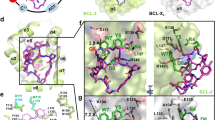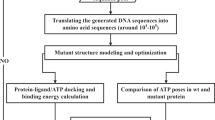Abstract
In an effort to find new pharmacological modalities to overcome resistance to ATP-binding-site inhibitors of Bcr–Abl, we recently reported the discovery of GNF-2, a selective allosteric Bcr–Abl inhibitor. Here, using solution NMR, X-ray crystallography, mutagenesis and hydrogen exchange mass spectrometry, we show that GNF-2 binds to the myristate-binding site of Abl, leading to changes in the structural dynamics of the ATP-binding site. GNF-5, an analogue of GNF-2 with improved pharmacokinetic properties, when used in combination with the ATP-competitive inhibitors imatinib or nilotinib, suppressed the emergence of resistance mutations in vitro, displayed additive inhibitory activity in biochemical and cellular assays against T315I mutant human Bcr–Abl and displayed in vivo efficacy against this recalcitrant mutant in a murine bone-marrow transplantation model. These results show that therapeutically relevant inhibition of Bcr–Abl activity can be achieved with inhibitors that bind to the myristate-binding site and that combining allosteric and ATP-competitive inhibitors can overcome resistance to either agent alone.
This is a preview of subscription content, access via your institution
Access options
Subscribe to this journal
Receive 51 print issues and online access
$199.00 per year
only $3.90 per issue
Buy this article
- Purchase on Springer Link
- Instant access to full article PDF
Prices may be subject to local taxes which are calculated during checkout






Similar content being viewed by others
References
Weisberg, E. et al. Characterization of AMN107, a selective inhibitor of native and mutant Bcr-Abl. Cancer Cell 7, 129–141 (2005)
Quintas-Cardama, A., Kantarjian, H. & Cortes, J. Flying under the radar: the new wave of BCR-ABL inhibitors. Nature Rev. Drug Discov. 6, 834–848 (2007)
Shah, N. P. et al. Overriding imatinib resistance with a novel ABL kinase inhibitor. Science 305, 399–401 (2004)
Gorre, M. E. et al. Clinical resistance to STI-571 cancer therapy caused by BCR-ABL gene mutation or amplification. Science 293, 876–880 (2001)
Nagar, B. et al. Crystal structures of the kinase domain of c-Abl in complex with the small molecule inhibitors PD173955 and imatinib (STI-571). Cancer Res. 62, 4236–4243 (2002)
Bradeen, H. A. et al. Comparison of imatinib mesylate, dasatinib (BMS-354825), and nilotinib (AMN107) in an N-ethyl-N-nitrosourea (ENU)-based mutagenesis screen: high efficacy of drug combinations. Blood 108, 2332–2338 (2006)
Adrian, F. J. et al. Allosteric inhibitors of Bcr-abl-dependent cell proliferation. Nature Chem. Biol. 2, 95–102 (2006)
Jahnke, W. & Widmer, H. Protein NMR in biomedical research. Cell. Mol. Life Sci. 61, 580–599 (2004)
Vajpai, N. et al. Solution conformations and dynamics of ABL kinase-inhibitor complexes determined by NMR substantiate the different binding modes of imatinib/nilotinib and dasatinib. J. Biol. Chem. 283, 18292–18302 (2008)
Nagar, B. et al. Structural basis for the autoinhibition of c-Abl tyrosine kinase. Cell 112, 859–871 (2003)
Hantschel, O. et al. A myristoyl/phosphotyrosine switch regulates c-Abl. Cell 112, 845–857 (2003)
Ray, A. et al. Identification of BCR-ABL point mutations conferring resistance to the Abl kinase inhibitor AMN107 (nilotinib) by a random mutagenesis study. Blood 109, 5011–5015 (2007)
von Bubnoff, N. et al. A cell-based screen for resistance of Bcr-Abl-positive leukemia identifies the mutation pattern for PD166326, an alternative Abl kinase inhibitor. Blood 105, 1652–1659 (2005)
Azam, M., Latek, R. R. & Daley, G. Q. Mechanisms of autoinhibition and STI-571/imatinib resistance revealed by mutagenesis of BCR-ABL. Cell 112, 831–843 (2003)
Azam, M. et al. Activity of dual SRC-ABL inhibitors highlights the role of BCR/ABL kinase dynamics in drug resistance. Proc. Natl Acad. Sci. USA 103, 9244–9249 (2006)
Branford, S. et al. High frequency of point mutations clustered within the adenosine triphosphate-binding region of BCR/ABL in patients with chronic myeloid leukemia or Ph-positive acute lymphoblastic leukemia who develop imatinib (STI571) resistance. Blood 99, 3472–3475 (2002)
Shah, N. P. et al. Multiple BCR-ABL kinase domain mutations confer polyclonal resistance to the tyrosine kinase inhibitor imatinib (STI571) in chronic phase and blast crisis chronic myeloid leukemia. Cancer Cell 2, 117–125 (2002)
Chou, T. C. & Talalay, P. Quantitative analysis of dose–effect relationships: the combined effects of multiple drugs or enzyme inhibitors. Adv. Enzyme Regul. 22, 27–55 (1984)
Mishra, S. et al. Resistance to imatinib of bcr/abl p190 lymphoblastic leukemia cells. Cancer Res. 66, 5387–5393 (2006)
Kornberg, A. & Pricer, W. E. Di- and triphosphopyridine nucleotide isocitric dehydrogenases in yeast. J. Biol. Chem. 189, 123–136 (1951)
Choi, Y. et al. N-myristoylated c-Abl tyrosine kinase localizes to the endoplasmic reticulum upon binding to an allosteric inhibitor. J. Biol. Chem. 284, 29005–29014 (2009)
Wales, T. E. & Engen, J. R. Hydrogen exchange mass spectrometry for the analysis of protein dynamics. Mass Spectrom. Rev. 25, 158–170 (2006)
Iacob, R. E. et al. Conformational disturbance in Abl kinase upon mutation and deregulation. Proc. Natl Acad. Sci. USA 106, 1386–1391 (2009)
van Etten, R. A. Disease progression in a murine model of bcr/abl leukemogenesis. Leuk. Lymphoma 11 (suppl. 1). 239–242 (1993)
Joensuu, H. et al. Effect of the tyrosine kinase inhibitor STI571 in a patient with a metastatic gastrointestinal stromal tumor. N. Engl. J. Med. 344, 1052–1056 (2001)
Lynch, T. J. et al. Activating mutations in the epidermal growth factor receptor underlying responsiveness of non-small-cell lung cancer to gefitinib. N. Engl. J. Med. 350, 2129–2139 (2004)
Kobayashi, S. et al. EGFR mutation and resistance of non-small-cell lung cancer to gefitinib. N. Engl. J. Med. 352, 786–792 (2005)
Cools, J. et al. Prediction of resistance to small molecule FLT3 inhibitors: implications for molecularly targeted therapy of acute leukemia. Cancer Res. 64, 6385–6389 (2004)
Blencke, S. et al. Characterization of a conserved structural determinant controlling protein kinase sensitivity to selective inhibitors. Chem. Biol. 11, 691–701 (2004)
Brown, E. J. et al. A mammalian protein targeted by G1-arresting rapamycin-receptor complex. Nature 369, 756–758 (1994)
Dudley, D. T. et al. A synthetic inhibitor of the mitogen-activated protein kinase cascade. Proc. Natl Acad. Sci. USA 92, 7686–7689 (1995)
Barnett, S. F. et al. Identification and characterization of pleckstrin-homology-domain-dependent and isoenzyme-specific Akt inhibitors. Biochem. J. 385, 399–408 (2005)
Burke, J. R. et al. BMS-345541 is a highly selective inhibitor of IκB kinase that binds at an allosteric site of the enzyme and blocks NF-κB-dependent transcription in mice. J. Biol. Chem. 278, 1450–1456 (2003)
Converso, A. et al. Development of thioquinazolinones, allosteric Chk1 kinase inhibitors. Bioorg. Med. Chem. Lett. 19, 1240–1244 (2009)
Tokumitsu, H. et al. KN-62, 1-[N,O-bis(5-isoquinolinesulfonyl)-N-methyl-l-tyrosyl]-4-phenylpiperazine, a specific inhibitor of Ca2+/calmodulin-dependent protein kinase II. J. Biol. Chem. 265, 4315–4320 (1990)
Lee, T. S. et al. Molecular basis explanation for imatinib resistance of BCR-ABL due to T315I and P-loop mutations from molecular dynamics simulations. Cancer 112, 1744–1753 (2008)
Strauss, A. et al. Efficient uniform isotope labeling of Abl kinase expressed in Baculovirus-infected insect cells. J. Biomol. NMR 31, 343–349 (2005)
Seeliger, M. A. et al. High yield bacterial expression of active c-Abl and c-Src tyrosine kinases. Protein Sci. 14, 3135–3139 (2005)
Oppi, C., Shore, S. K. & Reddy, E. P. Nucleotide sequence of testis-derived c-abl cDNAs: implications for testis-specific transcription and abl oncogene activation. Proc. Natl Acad. Sci. USA 84, 8200–8204 (1987)
Wales, T. E., Fadgen, K. E., Gerhardt, G. C. & Engen, J. R. High-speed and high-resolution UPLC separation at zero degrees Celsius. Anal. Chem. 80, 6815–6820 (2008)
Weis, D. D., Engen, J. R. & Kass, I. J. Semi-automated data processing of hydrogen exchange mass spectra using HX-Express. J. Am. Soc. Mass Spectrom. 17, 1700–1703 (2006)
Acknowledgements
We thank C. Henry and G. Rummel for technical assistance; R. Beigi for help with the bone-marrow transplantation studies; A. Velentza for performing the DSC experiments; and J. Kuriyan, M. Seeliger, C. Yun, M. Eck, E. Weisberg, D. Fabbro, P. L. Yang, G. Superti-Furga and A. Kung for helpful discussions. We also acknowledge the support of staff at beamline PXII of the Swiss Light Source, Villigen, Switzerland, during X-ray data collection, the ICCB-Longwood Screening facility at Harvard Medical School for the cell proliferation and enzyme assay, and Barnet Institute for hydrogen-exchange experiments.
Author Contributions F.J.A., J.Z., J.P., Y.C., G.L., M.A. and G.D. designed and performed cellular and biochemical experiments. J.Z. performed bacterial Abl expression and enzyme assays. W.J., N.V. and S.G. designed and performed the NMR experiments. S.W.C.-J. designed and performed the crystallographic experiments. G.F. and A.S. produced the protein for the NMR and X-ray experiments. T.S., Q.D., B.O., A.W. and X.D. designed and synthesized the compounds. A.G.L., C.D., F.S., G.-R.G. and T.T. conducted the in vivo studies. Y.L. and B.B. contributed to the design of the compounds. R.E.I. and J.R.E. performed and designed the hydrogen-exchange experiments. M.W. contributed to the design of the in vivo experiments. F.J.A., M.W. and P.M. provided critical input to the overall research direction. N.S.G. directed the research and wrote the paper with input from all co-authors.
Author information
Authors and Affiliations
Corresponding authors
Ethics declarations
Competing interests
F.J.A., W.J., S.W.C.-J., A.G.L., F.S., G.-R.G., Q.D., B.O., G.L., G.F., T.T., B.B., P.W.M. and M.W. are employed by Novartis Pharmaceuticals or the Genomics Institute of the Novartis Research Foundation. N.G. received research funding for this project from Novartis Pharmaceuticals.
Supplementary information
Supplementary Information
This file contains Supplementary Methods, Supplementary Tables S1-S3, Supplementary Figures1-15 and Supplementary References. (PDF 2083 kb)
Rights and permissions
About this article
Cite this article
Zhang, J., Adrián, F., Jahnke, W. et al. Targeting Bcr–Abl by combining allosteric with ATP-binding-site inhibitors. Nature 463, 501–506 (2010). https://doi.org/10.1038/nature08675
Received:
Accepted:
Published:
Issue Date:
DOI: https://doi.org/10.1038/nature08675
This article is cited by
-
In vitro evidence of synergistic efficacy with asciminib combined with reduced dose of ATP-binding pocket tyrosine kinase inhibitors according to the ABL1 kinase domain mutation profile
Leukemia (2024)
-
Structural mechanism of a drug-binding process involving a large conformational change of the protein target
Nature Communications (2023)
-
European LeukemiaNet laboratory recommendations for the diagnosis and management of chronic myeloid leukemia
Leukemia (2023)
-
Elucidating the potential effects of point mutations on FGFR3 inhibitor resistance via combined molecular dynamics simulation and community network analysis
Journal of Computer-Aided Molecular Design (2023)
-
Mast cell deficiency prevents BCR::ABL1 induced splenomegaly and cytokine elevation in a CML mouse model
Leukemia (2023)
Comments
By submitting a comment you agree to abide by our Terms and Community Guidelines. If you find something abusive or that does not comply with our terms or guidelines please flag it as inappropriate.



